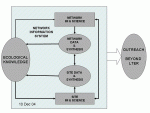NISAC committee working hard to facilitate LTER synthesis
Updates on some important developments from the Network Information System Advisory Committee (NISAC) and the progress of the Informatics Training and Software Usability Testing Lab at LNO.
In the last issue I highlighted progress on software, databases, and technical support projects at the LTER Network Office (The Network News Vol. 17 No. 2 Fall 2004). This quarter I update you on some important developments from the Network Information System Advisory Committee (NISAC) and the progress of the Informatics Training and Software Usability Testing Lab at LNO.
NISAC was appointed in Spring 2003. The group is made up of
LTER principal investigators:
- Tim Kratz (NTL)
- Mark Harmon (AND)
- Robin Ross (PAL)
- Deb Peters (JRN)
- Stuart Gage (KBS)
and Information managers
- Don Henshaw (chair, AND)
- Barbara Benson (NTL)
- Emery Boose (HFR)
- Peter McCartney (CAP)
and LNO representatives
- Bob Waide
- Bill Michener
- John Vande Castle
- James Brunt
- Mark Servilla
The Committee met four times in the last year and had numerous conference calls. In addition to setting ongoing NIS priorities at the Network Office, the group is developing a Network Information System (NIS) module selection process and a strategic plan for the Network Information System, revising the LTER Network Data Policies, and helping to refine information management review criteria.
NIS module selection process
NIS modules are specifically targeted information content for the NIS. To make decisions and prioritize the selection of new content, NISAC developed a process (since approved by the LTER Coordinating Committee (CC)) that names potential data types and outlines the process and documentation necessary to propose a new module. Adding content to the NIS helps document the progress of synthesis activities, and modules become Network resources that increase efficiency of future synthesis.
Network Information System Strategic Plan
NISAC is in the final phase of strategic planning that defines the mission and goals of the NIS effort and elaborates the strategies and actions necessary to make progress over the next four years. The draft plan defines NIS as an infrastructure for confederation and research collaboration depending on site data repositories, and comprising information technologies and information products resulting from research activities across LTER and its partners. NIS enhances information flows among data, synthesis, and knowledge about ecological systems (Figure 1). NIS will be implemented through the use of shared standards, software tools, training, and support, to integrate and provide compatibility across LTER sites, institutions, and researchers. The NIS strategic plan seeks to balance the development of short-term priority products with the development of long-term generic solutions and an improved network-wide infrastructure. While NIS serves primarily the LTER scientific community and collaborators, it is also a “portal” to LTER data products for the broader scientific community, natural resource managers, policymakers, and the general public.
LTER Network Data Policy Revision
A NISAC working group was charged with analyzing the current LTER site policies for the release, access, and use of LTER data. As a result, the group recommended:
- Expanding the current LTER Data Access Policy to cover the release of data and metadata
- Standardizing Network requirements for accessing LTER data
- Drawing up data use agreements specifying terms of acceptable use of LTER data
Consequently, revised LTER data release and general data use policies have been drafted and are in review. The adoption of these revised policies by the LTER Network is motivated by the needs:
- To ensure that the data release, data access, and data use language is consistent and clear across the network
- To standardize the approach to data access requirements for automated data distribution
- To standardize the requirements for data provision and use
- To ensure that the LTER Network data policies are consistent and interoperable with those of other NSF-funded programs
Re-evaluation of the policy serves to assure data providers that their data sets will be used appropriately and promotes a culture within the ecological community of making data available to the general scientific community in a timely fashion.
Information Management Review Criteria
NISAC is working with the Information Management committee to develop criteria for reviewing LTER site information management systems. The aim is to provide appropriate and unambiguous criteria to site information managers, management teams, and reviewers on the kind of data and information management standards the LTER Network expects of its sites. The effort is spearheaded by Emery Boose, and the document it has prepared is in its final phases of review and should be available for use after the Spring CC meeting.
The Committee will meet again in June with the Network Science Working Groups, which are charged with assessing current LTER information capabilities and IT infrastructure, and will work with the Science Task Force to define infrastructure models to support and facilitate the goals of synthetic research.
Drafts of all the documents mentioned above can be viewed on the LTER committees working area of the intranet (http://intranet.lternet.edu/committees/)
James Brunt
Associate Director for Information Management
LTER Network Office
For more informatics news, read Databits online at databits.lternet.edu

 Enlarge this image
Enlarge this image